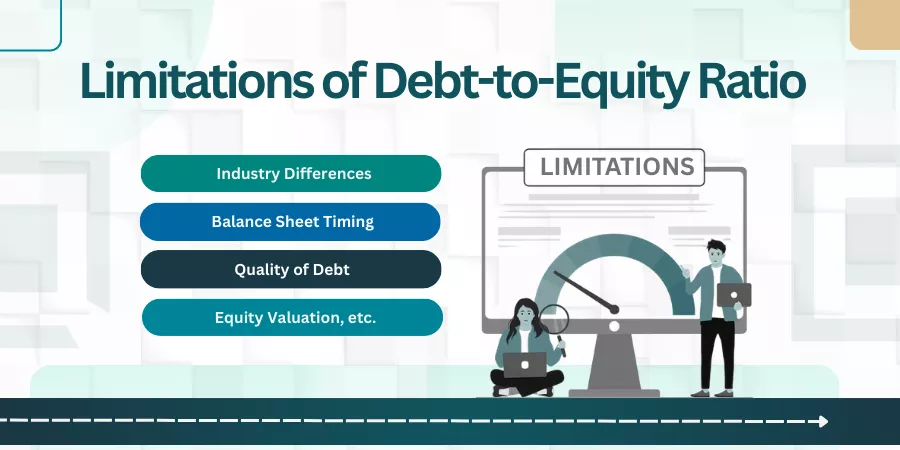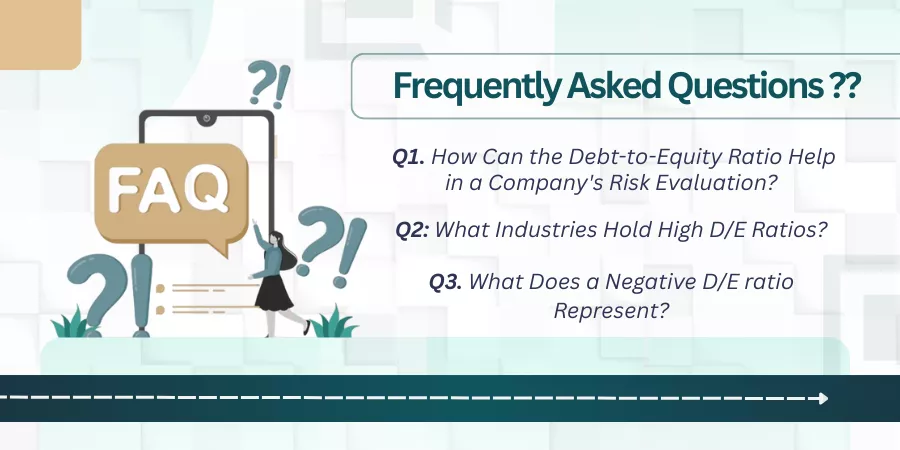Whether you want to invest in the stock market, or take your brand to new heights of success, understanding what is debt-to-equity ratio with example is crucial.
The debt-to-equity or D/E ratio is particularly valuable to industry leaders looking to one day go public. It’s an essential tool to gauge a company’s financial health. Creditors use the D/E ratio to determine potential loans, and investors depend on it to assess a business performance.
In this article, we will explore what is debt to equity ratio with example, debt-to-equity formula, debt-to-equity calculation, and why it’s crucial for anyone aspiring to grow their business or invest in an enterprise.
What is Debt to Equity Ratio with Example?
The debt-to-equity (D/E ratio) is an important financial metric that demonstrates the proportion of a company’s debt compared to its assets. Simply put, it shows how much of a company’s investment comes from borrowed money (debt) versus how much comes from investor funds (equity).
To calculate the debt-to-equity ratio, you simply divide the company’s total debts by its shareholder equity. This ratio is known as short-term debt, which indicates borrowings that the company must repay within a year, as well as longer-term debt obligations.
A low debt-to-equity ratio also indicates a company relies less on debt financing and is less risky in regard to its debt load. A company with a low D/E ratio has a lower proportion of debt than equity and has, therefore, less reliance on debt to finance its operations. So, low D/E ratio can lead to upscale your business.
On the other hand, a high debt-to-equity ratio indicates a company’s higher reliance on debt than equity. Higher debt levels can make it hard to tackle current debt obligations and take on more debt.
Carrying more debts leads to higher risks, as the company holds extra financial burdens which is challenging to pay if the company’s revenue decreases. However, a higher debt to equity ratio can also bring higher returns if the company uses leveraged funds to take its business to the next level.
It’s important to mention that the ideal debt-to-equity ratio can vary based on the specific company and industry. If a company uses more debt, it can earn more income. For example, on account of their business models, some industries, such as real estate and utilities, commonly hold high D/E ratios. If D/E ratio increases, so can the income.
How to Calculate the Debt-to-Equity Ratio Step by Step?
Calculating the debt-to-equity ratio is a simple method.
Here’s the formula:
Debt-to-Equity Ratio = Total Liabilities / Total Shareholder Equity
Follow these steps to calculate the ratio:
Identify Your Total Obligations
Total liabilities cover all short-term and long-term debts and obligations of your business. This information is shown on your company’s balance sheet. Examples of liabilities include loans, accounts payable, and other forms of debt.
Evaluate Shareholder Equity
Shareholder equity is the remaining interest in the company’s assets after excluding liabilities. This information is also available on your company’s balance sheet. Shareholder equity involves retained earnings, common stocks, and additional paid-in capital.
Calculate the Debt-to-Equity Ratio
Simply insert your numbers into the formula, dividing the total liabilities by shareholder equity. The result will be a whole number. If you want to display this number as a percentage, you can multiply it by 100.
Debt-to-Equity Ratio Example
As an example, let’s suppose a company holds total liabilities of $200,000 (734,000 AED) and shareholder equity of $500,000 (1,836,250 AED). Applying the debt to equity ratio formula, we get the result:
Debt-to-Equity Ratio = $200,000 / $500,000 = 0.4
This example company owns a debt-to-equity ratio of 0.4 or 40%, if represented as a percentage. In other words, for every dollar of equity the company possesses, the company owes 40¢ to lenders. There is a close connection between debt to equity. A good debt-to-equity ratio implies company’s financial stability.
The Advantages of Using the Debt-to-Equity Ratio
Determining the D/E ratio provides valuable insights of your business and equips you for success in various fields. Keep in mind, owning liabilities isn’t essentially a bad thing.
Some amount of debt might be inevitable to invest in inventory, marketing, and technology, which are compulsory for growing an ecommerce business.
The debt-to-equity ratio is necessary for businesses struggling with debt financing to generate more revenue and achieve financial goals. Investors often use this key metric to decide whether or not to invest in a company.
Equity financing is a common strategy for businesses aspiring to grow quickly. Similarly, having knowledge of how much shareholder equity is already dedicated to a business is an important metric for potential investors.
Investors also find out the D/E ratio to determine an organization’s financial health and risk profile. A well-balanced ratio makes a business more attractive to investors, as it represents a handsome balance between debt and equity financing. It’s why a debt-to-equity ratio is important for investors.
Bank loans often refer to the D/E ratio to decide whether a loan is approved or denied, as well as how much the loan is worth. Creditors use this ratio to analyze how much debt a company already owns and whether it can tackle additional borrowing.
Monitoring your D/E ratio also helps in financial risk assessment and track solvency and liquidity. High debt levels may be risky for an e-commerce business, particularly in volatile markets.
By finding your D/E ratio, you can create a balance between debt and equity financing and enable your company to sustain a healthy financial structure.
As there are various methods to calculate the debt-to-equity ratio, it’s critical to know which types of debt and equity you should include for balance sheet analysis. This maintains accuracy and consistency when finding your D/E ratio over time.
Limitations of Debt-to-Equity Ratio

While the debt-to-equity ratio is an important financial metric, it’s valuable to know its limitations when evaluating your company’s capital structure.
Here’s a breakdown of some fundamental limitations of debt to equity:
Industry Differences
When comparing benchmarks and D/E ratio, don’t overlook the industry-specific data. Each industry holds different standard D/E ratios. For example, capital-intensive industries like manufacturing often possess higher debt ratios than an e-commerce company.
What’s acceptable in one industry may be considered riskier in another.
Balance Sheet Timing
The debt-to-equity ratio depends on the balance sheet, which is a picture of your company’s financial leverage at a specific point in time. Fluctuations in equity or liabilities that happen after the balance sheet date may, therefore, not be considered.
Established businesses may show considerable variations in the debt-to-equity ratio based on when you or your accountant organize your balance sheet.
Quality of Debt
When assessing your level of debt, it’s important to note the quality and terms of your debt. The debt-to-equity ratio doesn’t distinguish between types of debt (for example, short-term versus long-term or low-interest versus high interest). Some types of debts are riskier than others and the standard D/E ratio doesn’t highlight this.
Equity Valuation
The ratio employs the book value of total equity, which may not correctly represent the current market value. This can result in an overvaluation or undervaluation of your company’s financial leverage.
The ratio may also include intangible assets with individual perspectives that can change over time, impacting its credibility.
Growth Stage
When comparing your debt-to-equity ratio to benchmarks, remember your company’s growth stage and set expectations accordingly. Businesses at different phases of growth may naturally exhibit different D/E ratios.
Startups may demonstrate higher ratios on account of initial funding needs, while seasoned companies may show lower ratios due to high income streams.
Profitability and Cash Flow
The D/E ratio neglects your company’s profitability or ability to produce cash flow. A high debt-to-equity ratio may still be tolerable if you generate solid and stable cash flows. The ratio also doesn’t consider off-balance-sheet debts, which might affect your company’s proper financial leverage.
The Bottom Line
The debt-to-equity ratio is valuable for investors to recognize highly leveraged companies that may indicate risks during business downturns. Investors can compare a company’s D/E ratio to industry averages and competitors. However, a high debt-to-equity ratio does not always indicate poor business prospects.
In fact, debt can allow a company to thrive and generate more revenue. But if a company is increasingly reliant on debt for its growth, potential investors would investigate further to invest in it.
Want to learn more about what is debt to equity ratio with example and debt management strategies? Quadrawealth investment advisors can help you make informed decisions about investments and achieve your financial goals.
FAQs

Q1. How Can the Debt-to-Equity Ratio Help in a Company’s Risk Evaluation?
A: A constantly increasing debt-to-equity ratio may make it challenging for a company to gain financial backing in the future. The rising dependency on debt could finally cause difficulties in managing the company’s current loan obligations.
Q2. What Industries Hold High D/E Ratios?
A: Banking and financial service sectors usually demonstrate a high debt-to-equity ratio. Banks commonly have higher amounts of debt because they possess significant fixed assets in the form of branch networks.
Similarly, companies with higher debt-to-equity ratios typically dominate in other capital-intensive sectors, greatly reliant on debt financing, such as industrials and airlines.
Q3. What Does a Negative D/E ratio Represent?
A: A negative debt-to-equity ratio of a company signifies a negative shareholder equity. In other words, the company’s debts increase more than its assets. In most cases, it signals a high risk and an incentive to find bankruptcy protection.






